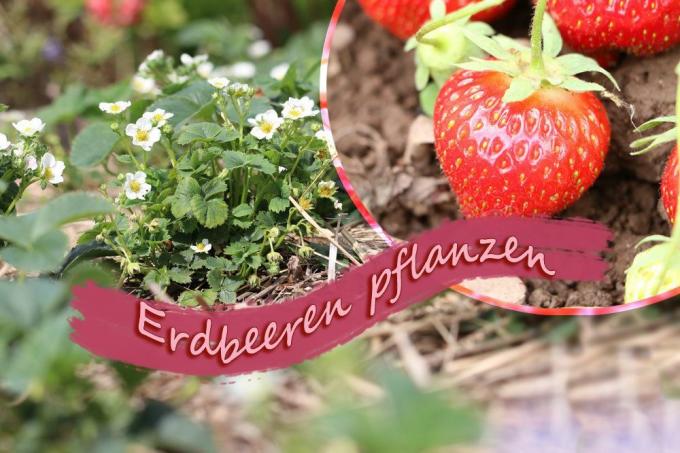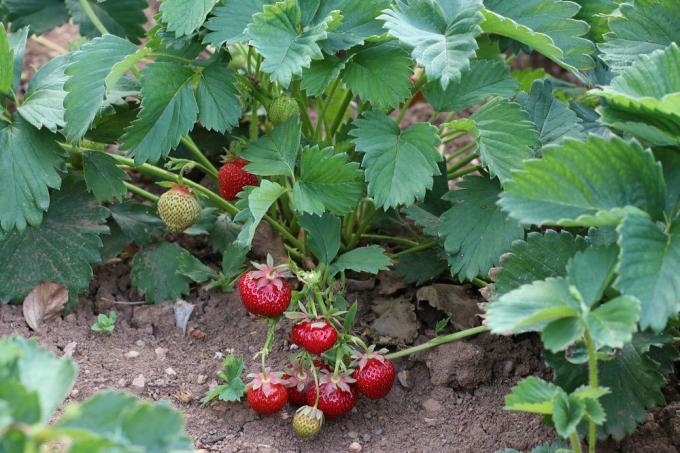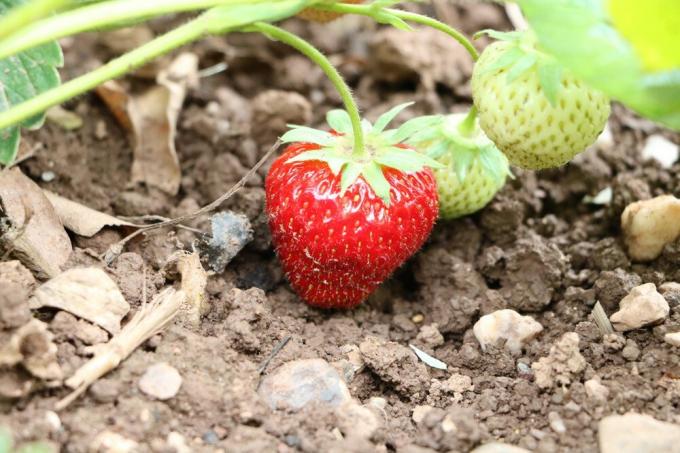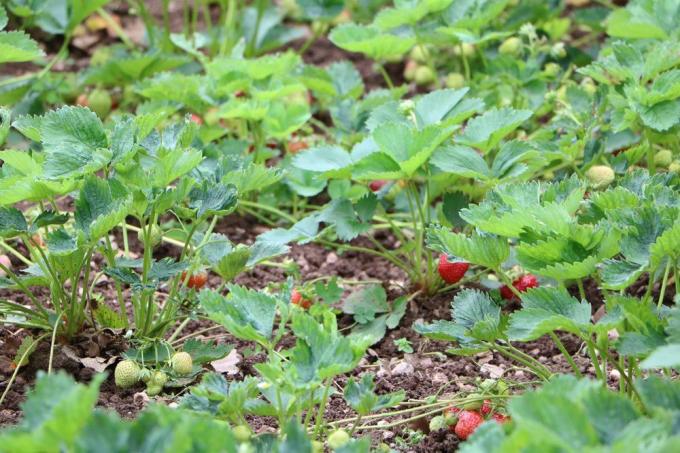
table of contents
- Planting time
- Quality of the seedlings
- Note crop rotation
- Choice of location
- Soil preparation
- planting
- Culture in pots and tubs
Strawberries (Fragaria) are one of the most popular types of fruit in this country. They are popular with young and old alike. The fruity-sweet to slightly sour berries can be harvested as early as the beginning of June, depending on the weather and the degree of ripeness of the different varieties. A strawberry patch should therefore not be missing in any garden. Because planting strawberries is not particularly difficult. Here are a few tips for correct planting so that nothing stands in the way of a rich harvest every year.
Planting time
Usually the optimal planting time is in late summer until autumn, more precisely from mid-July to the end of August. The plants need a lot of warmth in order to grow well and survive the winter unscathed. If the plants get into the soil too late in autumn, they can quickly rot. Planting in autumn also lays the foundation for a rich harvest in the following year.
If, however, the planting time was missed in autumn, perhaps because the bed was not yet prepared, planting can still take place in spring. Planting should then be finished by April at the latest. The earlier, the better the harvest in the first year.
A brief overview of all planting dates:
- July to August ideal, especially for strawberries that have been in production several times
- September, new plantings still possible in mild regions
- March to April if summer planting has been missed, mainly monthly and climbing strawberries
- May to mid-June is the best time to plant frigo plants
tip: Frigo plants are normal strawberry plants that are cleared from November to February and then stored in a cold store at -2 ° C in order to artificially extend the winter. The first harvest can be expected exactly eight to nine weeks after planting.
Quality of the seedlings
Only high quality young plants should be planted. These must have a strong heart bud, at least three healthy leaves and a stable root system. Strawberry plants are commercially available in three forms.
Green plants
- packed in waterproof plastic bags
- thus keeping it fresh for a long time
- if no immediate planting, loosen foil slightly, keep plants moist (damp kitchen towel)
- when planted in August, good yield the following year
- susceptible to drought
Frigo or frost plant
- are already a year old
- Clearing in winter and subsequent storage at -2 ° C
- available from March to August
- further storage at home in the refrigerator at 0 ° C is possible
- best planting time April to mid-June
- first fruits after eight to nine weeks
- staggered planting can extend the strawberry season in the first year
Potted plants
- most expensive alternative
- Young plants grown in soil are usually relatively small
- root ball well rooted
- packed in plastic containers
- still sensitive to frost, so do not plant too early in spring
- If necessary, protect from the cold, even when planting in autumn
- if planted early, very good yields in the following year
- low yields in the same year if planted in spring
Before planting, you must always water all strawberry plants thoroughly so that they can still draw enough water.
Note crop rotation
Strawberries are very sensitive to reproduction. In other words, you should definitely not plant in a place where strawberries or potatoes were just standing. There must be a period of at least four years between plantings. Otherwise it can lead to soil fatigue. The soil is leached out on one side and soil pests such as nematodes can also settle unhindered. Vegetables with a short cultivation time such as
- Kohlrabi
- Salad or
- radish
tip: Crop rotation is the alternating cultivation of crops on the same soil. As a result, the soil fertility is sustainably renewed and maintained.
Plant strawberries in mixed culture
After three years at the latest after planting, the yield and quality of strawberries decline continuously, and in light soils after two years. It is then time to change location. In order to keep an overview, a written cultivation plan is extremely helpful.
Alternatively, strawberries can also be used in Mixed culture can be grown in rows. After three years, all you have to do is change the row. As neighbors for strawberry plants are particularly good
- Garlic with its bactericidal and fungicidal properties
- Onions, leeks and chives are good against fungal diseases, spider mites and snails
- Borage to promote the set of flowers
- Marigolds and marigolds against nematodes and wireworms
Choice of location
Before you start planting, it is important to find the optimal location, because this is essential for successful cultivation. The light and floor conditions must be taken into account.
- full sun, the sunnier the sweeter the fruit
- Forest and monthly strawberries thrive in partial shade
- sheltered from the wind, but not calm
- Foliage needs to dry quickly after rain to avoid leaf diseases
- loose, humus and nutrient-rich, deep soil
- compacted soils promote root diseases
- no waterlogging and weeds
- Soil must not be freshly dug
- Soil pH 5.5 to 6.5 (slightly acidic)
- Consideration of the crop rotation
- welcome previous crops: lettuce, parsley, kohlrabi, radishes
Soil preparation
Strawberries will normally thrive in any good garden soil, provided that it has been thoroughly prepared for the planting of strawberries:
- Dig the soil deeply with a digging fork at least 14 days before planting
- alternatively, the bed can be prepared for spring planting in late autumn
- Then with a cultivator, humus or leaf compost, peat waste or rotted manure (4-5 liters / m²) and 30 g horn meal are introduced
- work everything flat into the ground
- Alternatively, special complete strawberry fertilizers can also be used
- 6 to 8 kg are required for 100 m²
- Spread full fertilizer broadly and work it well into the soil
- If the crop has been cultivated for several years, the fertilizer application must be repeated annually after the harvest
- in heavy soils to loosen up, incorporation of compost or sand
- Improve sandy soils with compost or rock flour (clay flour)
- adding basalt flour helps with damp soils
- Let the soil rest for 14 days after cultivation so that the soil can settle
- then rake the bed until it is smooth
Once the soil has been tilled, nothing stands in the way of planting. At most one more thing, in the case of potted plants, the root ball must be well watered before it gets into the ground. Bare-rooted plants should stand in the water for a few hours.
planting
Strawberries should be planted when the soil is moist and not necessarily when the heat is low. Plants that do not get into the ground immediately must then continue to be stored in a cool place and moistened at intervals. The important thing is always Row spacingso that there is enough space when harvesting. This depends on the duration of the cultivation and the size of the bed.
- for annual crops, a row spacing of 50 cm and within the row 20 cm between plants
- For perennial cultivation, row spacing of 50 to 80 cm (but at least 60 cm) and within the row 30 to 35 cm between plants
- promote distances that are too small Diseases and pests
Furthermore, the following must be taken into account when planting:
- Dig the planting hole deeply, there must be space for roots without compression
- in potted plants, excavate at the level of the pot
- Place bare-root plants vertically in the planting hole, they must have space to spread
- Do not set plants too deep or too high
- The heart of the plants must be just above the surface of the earth
- Fill in the soil and press firmly
- water well
- use of rainwater if possible
- If the dryness persists, water mornings and evenings
- Spreading straw between plants, removal after harvest
- Straw offers protection from weeds and snails, keeps moisture in the ground and fruits do not lie on the ground
The growing period lasts approximately 10 to 14 days. The soil must be kept moist during this time. But even after that, the earth must not dry out completely.

tip: In order to extend the harvest time and higher yields, you should always plant different varieties, both early and late, in combination with self-pollinating strawberries.
Culture in pots and tubs
Strawberries can also be grown wonderfully as potted plants on balconies and patios. Robust, everbearing plants are particularly suitable for this, with a harvest until October like
- Camara
- Cupid
- Siskeep
However, you should note the following:
- sunny location
- Pot with a diameter of at least 20 cm and just as deep
- There must be water drainage holes, drainage (expanded clay) must be installed
- Potting soil with organic fertilizer
- winter frost-free in a cool, dark place for the first year
- Don't forget to pour
- Cut back plants in autumn so that fruits appear in the following years


